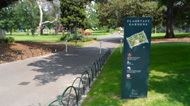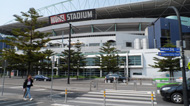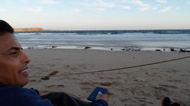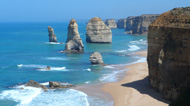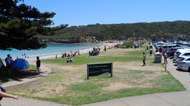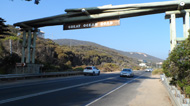Flagstaff gardens |
Spencer street |
Marvel stadium |
Koala at Maru koala Park |
Melbourne |
Melbourne is the capital of the state of Victoria, in south-eastern Australia, and is the second most populous city in Australia after Sydney. It corresponds to the largest conurbation informally called Greater Melbourne, made up of 31 municipalities which, overall, encompass about five million people, making it the second most populated urban area of ??the federation after Sydney. The municipality called City of Melbourne represents its historic center and is the capital of the State of Victoria. Often referred to as the "cultural capital of Australia" and "Garden City", Melbourne is an undisputed international cultural center, and was the second city in the world after Edinburgh to be named a "Literary City" by UNESCO. Australian cinema (as well as the first feature film in the history of cinema), Australian television, Australian impressionist art and a long series of artistic currents, from music to literature, was born in Melbourne. A multicultural city par excellence, Melbourne finds further points of excellence in sport and in the variety of foods and traditions. Also for this reason it has been named for seven consecutive years the "most livable city in the world" according to the special ranking drawn up by The Economist. The city of Melbourne was founded in 1835 by an Australian man named John Batman. However, the area was initially abandoned because it lacked of clean water. The founders then moved up the Yarra River and reached the place now occupied by the city. The Williamstown port however continued to be used as the ships' first landing point. It is known as Giem Pier and can still be visited today. The region, at present known as Victoria, was inhabited by the indigenous people Kulin and then disputed by the British and French. One of the first Brits who settled in that area was John Batman, a very successful land administrator, who, although he was denied permission to set up a colony by the governor of New South Wales, already having one in the area, signed an agreement with some Aborigines for the purchase of approximately 2,000 kmē of arable land in present-day Melbourne, as well as other lands near Geelong, in the south-east, in Corio Bay. At the same time as Batman, another businessman, John Pascoe Fawkner, went with his ship the Enterprize near the Yarra river to establish a settlement. The groups, led by the two men, then decided to divide the territory and to found, in March 1837, a city that was shortly named Melbourne in honor of the British Prime Minister of the time, Lord William Lamb viscount of Melbourne. From September 1836 it became the administrative center of the Port Phillip district in New South Wales. The government was first represented by a magistrate who was William Lonsdale and then in October 1839 by the superintendent Charles Joseph La Trobe, a man with scientific and musical interests who greatly contributed to the cultural formation of the current city. In 1851 the white population of the Port Phillip district was still 77,000, although it had already become an important center in the export of wool to Australia and that only 23,000 people lived in Melbourne. Prior to the gold rush boom most of Melbourne's buildings were made of timber with the exception of St James Old Cathedral on Collins Street (now relocated in theFlagstaff Gardens), and St Francis Catholic Church on Elizabeth Street. An agitation of the settlers in July 1851 made Victoria a separate colony and La Trobe became a lieutenant-governor. A couple of months later, gold was discovered near Ballarat and Bendigo, which changed Melbourne and the state of Victoria a lot. Even after the gold rush, economic development continued to be dizzying, and the first bank on the continent was founded here. At the end of the XIXth century the city was a true metropolis, full of splendid Victorian buildings. It was in that period that the expression "Marvelous Melbourne" was coined. The golden age began to end in 1891, when a deep economic crisis hit hard the city. However in 1901, with the foundation of the Commonwealth of Australia, the city was chosen as a temporary capital pending the completion of the construction of Canberra (the government was transferred to it only in 1927). Melbourne subsequently experienced a great growth during the Second World War (due to the orders of war) and in the immediately following period, when a flood of immigrants, primarily British and Irish, but also Southeast Asians, Greeks and Italians, poured on the city. In 1956 the XVI Olympiad was held here. Melbourne remained Australia's main financial center until the 1970s, but Sydney, by the turn of the century, surpassed it by population. Even today Sydney is the largest city in Australia. Melbourne is a large commercial and industrial center. Many of the Australian multinationals are based in the city and there are automotive industries such as Toyota, Ford and Holden as well as several other manufacturing industries. The most famous market in the city is the Queen Victoria Market which started its activity on March 28, 1878. The market sells fish and meat of all kinds, vegetables and fruit, clothing and handicrafts of the Aborigines. Another market is located in the southern part of Melbourne, in particular, in the area delimited by York street and Cecil street and the Kilda street railway line. This market started operating in 1867 and is still functioning today; among the stalls you can buy: fresh food, handicrafts and much more. Melbourne is renowned throughout the nation for the dozens of shopping malls connected together by indoor bridges that make it a great economic hub. From the culinary point of view, there are many Korean restaurants in the city, given the large presence of these tourists. In the city, an experience worth doing is to go to the Eureka skydeck 88. This splendid skyscraper reaches a height of 300 meters, and is the tallest in the entire southern hemisphere. It also ranks first in the ranking of the tallest habitable buildings in the world. Located in the heart of the Southbank district, a few steps from the Yarra River, it offers a 360 ° view of the entire city, the bay, all the monuments and other main skyscrapers. In the distance it is even possible to see the mountains. A panoramic terrace located on the 89th floor allows visitors to enjoy a unique panorama, especially during sunset and in the evening, when the sunlight is replaced by a myriad of colored lights throughout the city. The elegant design of the Eureka Tower, with its top covered in gold, has ensured Melbourne's reputation as a new architectural icon.
A cruise along the Yarra River is also an excellent experience to enjoy the beauty of the city and the skyscrapers. Certainly worth visiting in the city is Flinders station, the city's central railway station, completed in 1854. The terminus was the first city railway station in Australia, and on the day of the inauguration it was characterized by the first journey of a steam train across the continent. Also the Queen Victoria Market consisting of numerous sections, this open air market is the best known of all the State of Victoria. For 130 years it has been the destination of Melbourne's inhabitants and many foreign visitors, who go there to admire the works of local craftsmanship, including above all the famous boomerangs, and buy souvenirs of all kinds and values. The prices are much lower than those of any other shop in the city, making it an ideal place for shopping. The atmosphere of this historical place is cosmopolitan and vibrant with life, sounds and perfumes. In addition to clothes, shoes, jewelry and handicrafts, fresh products are also sold, such as fruit, vegetables, meat, chicken, fish and sweets. Sunday is most dedicated day to the sale and display of souvenirs and typical works. Remember that you can get around the city for free, inside the free tram zone. In the city map that can be requested at the hotel reception, you can locate the various stops where, similarly to the hop on and hop off bus, you can leave and take the tram
(# 35) visiting the city without spending a cent. Excursions outside Melbourne that deserve an experience are Philipp Island to attend the parade of blue minor penguins returning to their lairs at dusk after a day of fishing at sea (full day: 12 hours/AU$ 140). The excursion also includes a visit to Maru koala Park to see kangaroos, koalas, emus, dingoes and other animals. Another excursion that needs to be done is Great Ocean Road and 12 Apostles (full day: 12 hours/AU$ 168). The excursion includes stops in the towns of Colac, Apollo Bay, Lorne and visits to the legendary 12 Apostles, the rock formations located along the coast overlooking the sea. From the airport you can reach the center (Spencer street) with the skybus,
which leaves every 10 ',
and takes 24'/AU$ 19.50/25 Km.
